Catholic Customs
 |
 |
 |
 |
 |
 |
 |
The Blessings & Symbolism of the Easter Egg
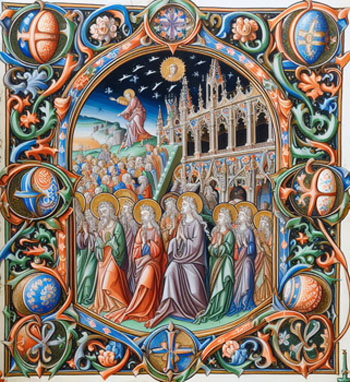
A medieval manuscript of Christ’s Final Coming adorned with colorful eggs
Our ancestors regarded the egg as a sacred object symbolic of and filled with new life. For an egg appears to be a dead, inanimate object, but from it emerges a living creature. It is at it were a seed of life, within it the embryo becomes a bird.
People all over the world have observed this wonder and marveled. Many pagan cultures placed eggs in houses, fields and barns to bring blessings and protection from misfortune. Eggs were also used in marriage and funeral rights as sacred objects imparting new life. (1)
When these peoples became Catholic, they saw that this wonder was created by God to signify an even greater wonder, the Resurrection of the Man-God. What joy it was for the newly converted Catholics to thus offer the egg, their sacred object, as an Easter tribute to Our Lord.
The blessings & symbolism of the Ester Egg
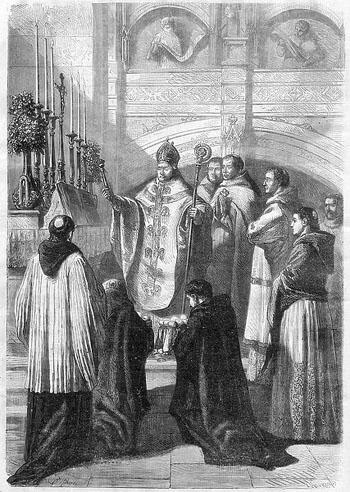
The Blessing of Eggs at the Abbey of Solemes
"We beseech thee, O Lord, to give the favor of Thy blessing to these eggs: that so they may be a wholesome food to Thy faithful, who gratefully take them in honor of the Resurrection of Our Lord Jesus Christ. Who liveth and reigneth with Thee, forever and ever. Amen." (2)
Our Risen Lord received a fitting emblem in the egg: The egg’s shell represented His Body; the egg white, His soul; the egg yolk, His Divinity. (3)
The mythical phoenix also became an emblem of Our Lord, for this noble bird after having lived a thousand years in a paradisiacal grove, was said to fly to a palm tree in Syria where it built for itself a funeral pyre and died bursting into flames. From its ashes was formed an imperfect body that took the shape of an egg until the phoenix’s body regained its former form and burst from its shell filled with youthful life and beauty. (4)
The egg’s close connection with Our Lord inspired its incorporation into liturgical art. A baptismal font in Alsleben bei Zerbst has a carving of Our Lord at His Resurrection arising from the shell of an egg. (5)
The Catholic man of the past saw significance in the time and season in which the natural world brought forth her fruits. Holy Thursday and Good Friday, being sacred days in which Our Lord consummated His Sacred Passion were held in special regard, and close attention was given to the eggs laid on these days.
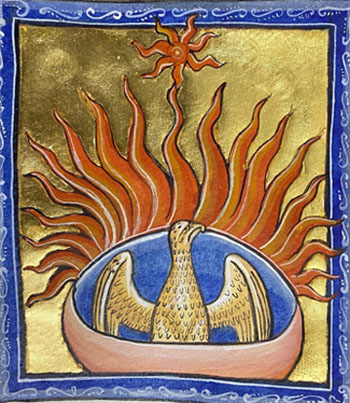
Like Our Lord bursting from his tomb, the phoenix bursts from his shell
Many people of the British Isles had special regard for the eggs laid on Good Friday. They were eaten on Easter Sunday in Ireland, and those who partook of them hoped to be preserved from sickness throughout the coming year.
In some parts of England, the eggs were kept out of the way and undisturbed until December when they were used to make the Christmas pudding. An Englishman’s letter written in 1921 remarks that he witnessed the making of the Christmas pudding with such an egg and the egg had been preserved and was not rotten. (6)
The mysterious origins of the painted Easter Egg
The practice of coloring and decorating eggs is very ancient. In Europe, eggs were painted from at least the fourth century; a painted egg was discovered in a fourth century tomb of a girl in Worms, Germany. Numerous legends from different countries attempt to explain the origin of the painted Easter egg.
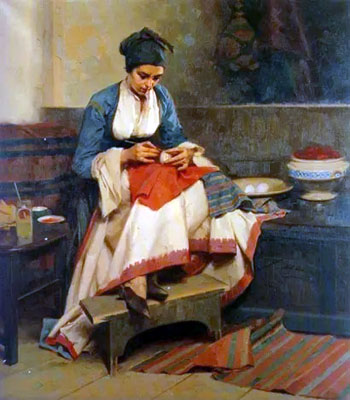
A Greek peasant woman decorates an egg
An old Slavic legend says that when Our Lord was carrying His Cross through the streets of Jerusalem, a man who was bringing his eggs to the market saw Our Lord and left his eggs to help Him carry the Cross. When he returned to his eggs, they had turned into many beautiful colors and he was able to sell them for a good price. (8)
Yet another legend says that Our Lady brought eggs to the soldiers on Calvary endeavoring to convince them to be less cruel. At the sight of their cruelty and the sufferings of her Son, she wept bitter tears that fell upon the eggs and left brilliantly colored dots on each spot that they touched. (9) The Romanians have a similar legend, telling that Our Lord’s Blood fell on the eggs dying them red and that afterwards Our Lady made red eggs a symbol of Christ’s Blood. (10)
Egg designs & regional diversity
The task of painting or dying eggs became a sacred activity carefully perfected by the women of Central and Eastern European countries. Every village had its unique design and method of coloring the eggs; charming legends and verses explained the origin of each design. These same designs would be placed on embroidered clothing, furniture and house interiors. So distinct were the designs that a stranger’s town of origin could be deciphered by the design on his eggs.
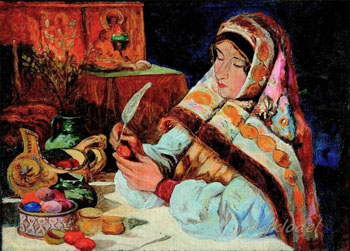
An Eastern European woman prepares her eggs with great art & care
In addition to these ornate eggs, palace cooks and housewives dyed and boiled as many as a hundred eggs a single color to be distributed to friends and family during Easter Week.
In the early hours of Holy Thursday or Good Friday, the women of the family closed themselves in a secluded room into which no man could enter until they had completed their important duty of dyeing and decorating the Easter eggs.
Good Friday was the preferred day for the Russians, Poles and Hungarians, while the Greeks and Bulgarians prepared their eggs on Holy Thursday. Each region developed a unique ritual that determined how and with what materials the eggs were to be decorated.
The most typical methods are as follows: a colorful design is painted on the eggs; wax is applied to the eggs before dying to create intricate patterns; a needle is used to engrave designs on the already dyed egg; or straw, foliage, flowers or colored paper is used to adorn the eggs. (12)
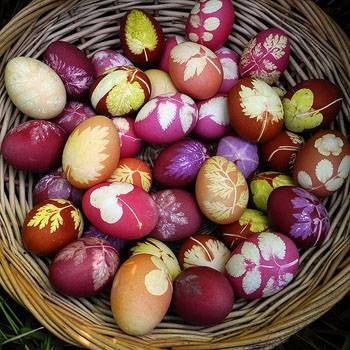
Eggs dyed with herbs and flowers
In Greece, the red dye that was used had to be obtained from a specific type of red-wood with no other added ingredients. Russians boiled their eggs in onion skin to obtain a vibrant red hue and painted them with birch or thyme leaves (14)
In England and the Northern countries, the people used the spring leaves, moss and flowers to decorate their eggs, which appeared to be bursting with the new life of the earth. The Scandinavians decorated their eggs with special flower designs. In the 1400s, the Italians adopted this same method of dyeing eggs. (15)
The egg continues to be a sign of joy and hope for Catholics living in these days. For Christ is truly Risen, reigning gloriously from His throne in Heaven throughout the ever changing ages of this world. And just as the Head of the Church has Risen, His Mystical Body, the Church, will also share His victory after she passes through the Passion she is presently experiencing.
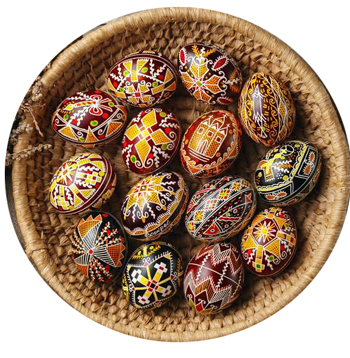
Ukranian Easter eggs
- Venetia Newall, “Easter Eggs,” Folkore 79, No. 4 (Winter, 1968), pp. 257-263.
- Dom Prosper Guéranger, The Liturgical Year, vol. XIII (Fitzwilliam, New Hampshire: Loreto Publications, 2013) p. 153.
- http://www.brauchtumsseiten.de/a-z/o/ostereier/home.html
- https://www.newadvent.org/fathers/0707.htm
- Newall, “Easter Eggs,” p. 267.
- James Mooney, “The Holiday Customs of Ireland,” Proceedings of the American Philosophical Society 26, No. 130 (Jul.- Dec., 1889), pp. 388-389.
- https://www.monasteryicons.com/product/story-of-the-first-easter-egg/did-you-know
- https://polishatheart.com/polish-easter-dishes-from-our-grandparents-to-the-future
- https://www.monasteryicons.com/product/story-of-the-first-easter-egg/did-you-know
- Agnes Murgoei, “Roumanian Easter Eggs,” Folklore 20, No. 3 (Sep. 30, 1909), pp. 297-298
- Madeleine Pelner Cosman, Medieval Holidays and Festivals: A Calendar of Celebrations (New York: Charles Scribner’s Sons, 1981), pp. 42-43.
- Sophie Hodorowicz Knab, Polish Customs, Traditions, and Folklore (New York: Hippocrene Books, 1996), p. 100.
- Mercia MacDermott, Bulgarian Folk Customs (London and Philadelphia: Jessica Kingsley Publishers, 1998), p. 207-208.
- George A. Megas, Greek Calendar Customs (Athens: B. and M. Rhodis, 1963), p. 94; See also: Polina Rozhnova, A Russian Folk Calendar (Moscow: Novosti, 1992)
- Carol Field, Celebrating Italy (New York: William Morrow and Company, 1990), p. 421.

Posted March 20, 2024
______________________
______________________
 |
 |
 |
 |
 |
 |


